Vifa C17WH-69-08 + SEAS 27TFFC
Copyright
2006-16 © Troels Gravesen
CROSSOVER
CABINET
MEASUREMENTS
OLD
C-17
DRIVERS
2-way d'Appolito
Get
95 dB/2.8 volts sensitivity for your low-wattage amp - in
case it runs 4 ohms speakers.
Go to:
C17-II
Go to:
C17-III
Go to:
C17-IV
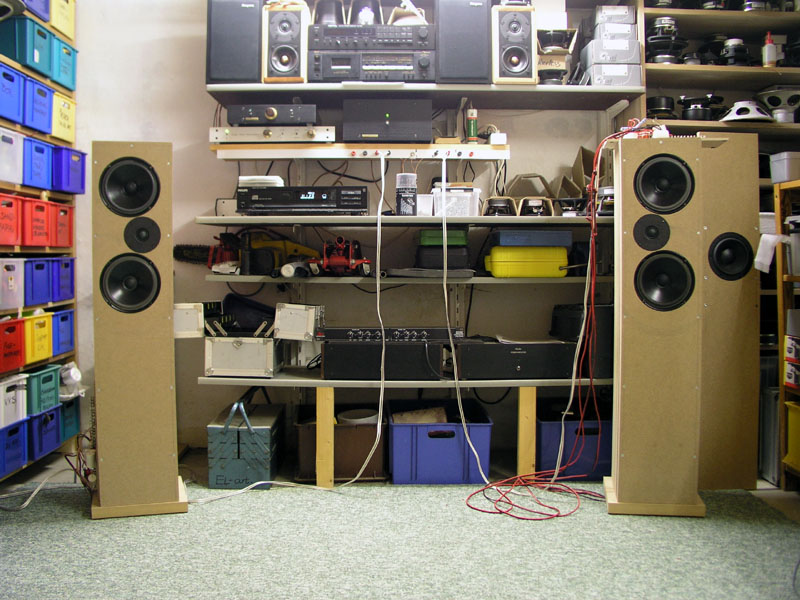
Workshop set-up with a d'Appolito arrangement in 39
litres vented cabs.
These speakers are sensitive! Watch that
volume knob before you turn on the music.
The Vifa
C17WH-69-08 is a "special" driver.
Special because it's so ordinary - probably made in tenth
of thousands - and special because a lot of things went
right with this driver. Sometimes a driver turns out to
have the right cone material and coating for a given
size, thickness and weight; the right voice coil
diameter; the right surround providing the right damping
to cone motion; the right magnet size to provide useful
TS-data, etc. When all the individual parts are made
right, the result may be better than what we might expect
from the sum of the parts.
A curvilinear cone like this will mostly have a smooth
frequency response compared to a straight-sided and deep
cone like the Philips 9710 and this Vifa C17WH-69-08 is
no exception. It's basically flat up to 2-3 kHz and what
happens above, is a series of modest resonances that are
easily taken care of in the crossover. A straight sided
cone, like the Philips 9710, has great bass performance,
but above 2-3 kHz the response rises some 10 dB and sharp
filters are needed.
So here we have a stamped metal
chassis, thin paper cone and a foam surround.
Some 15 years ago we might have rejected this driver as a
useless old-timer. Yet it must be one the most
often used drivers. Basically it costs nothing and some
may reject this driver due to the fact that it carries a
foam surround that will rot in 15-20 years time. Applying
some thin silicone liquid to the foam may extent its
lifetime but don't use silicone spray due to the solvent
used. It must be pure silicone with no additives. The
type of silicone that comes in a bottle with a small
brush is usually good. A foam surround may be one of the
tools to make a better than average midrange
presentation. Foam surrounds are still around - and for
good reasons. G. A. Briggs found the foam surround
superior to corrugated paper and cloth some 45 years ago
- but unfortunately didn't compare with rubber. Very
little can be found in the books of Colloms and Dickason
on the impact on sound and overall performance of drivers
due to various outer surround materials.
As long as the C17WH is
not forced to play excessively loud, it can deliver some
of the best midrange performances available . If driven
too loud, it starts sounding compressed, but which driver
doesn't? Well, the Audio Technology 15H52 is one, but
that's another story for the wide baffle section. The C17
is found in numerous versions, most often the
"WG", fitted with a smaller magnet and allowing
decent bass from a small cabinet. The "WH" has
a larger magnet and sensitivity around 90-91 dB/2.8 volts
and from two in parallel we may expect minimum 95
dB/2.8V. However, this will result in an impedance of 4
ohms, or rather 3.5 ohms. So possibly not the ideal
partner for single ended triodes. But push-pull triodes
and small class A amps may like it a lot. We'll see.
(I've already had the question if the "WG" can
substitute the "WH" in this construction and
the answer is no. Different driver = different crossover
and box tuning).
The C17WH-69-08 is not an easy
driver to find and it is no longer in the Vifa
catalogue. I found a local dealer having some boxes of
C17 drivers and I bought four. Try a Goggle search for
"Vifa C17WH" and you will find a few dealers
still having these drivers.
Make sure the foam surround is looking reasonably fresh
and do the nail test before buying. Squeeze a nail into
the foam close to the perimeter of the surround and if
you are left with a mark and the foam doesn't rise again,
we have an old surround that may only last a few years.
This driver came to my attention from visiting a guy
having a speaker system from a single C17WH-09-04 in a
rather special box. For mid the Vifa was supplemented by
an excellent 3" Brazilian pp upper midrange (Bravox)
with foam surround, and for treble a 25-something SEAS
tweeter. The C17 was housed in an 18 litres vented
enclosure where a square, wooden "vent" was
loaded by a short exponential horn. I haven't got the
drawings but I'll try to push him hard to reveal some
more details.
The C17 is also very well know
from the Living Voice d'Appolito and a low-cost version
is some 1500£.
http://www.livingvoice.co.uk/home.htm.
Now, Living Voice may possibly use 10 ohms (DC resistance) drivers
to make an overall claimed impedance of 6 ohms. I haven't
seen any reviews including measurements on this speaker.
The Living Voice is using a C17 version with a larger
magnet compared to this C17WH and the crossover appear to
be 6/12 dB and an LCR circuit is keeping the impedance
flat in the midrange. To have the C17WH contributing in
the treble area may be appealing to some, but to me it
isn't. Having the treble beaming at you due to a large
cone is not nice, neither from the C17, nor from any
other driver.
The C17WH is very much in
family with the old SEAS CA17RCY, which Wilson Audio used
in the first WATT and the first WATT/PUPPY. The SEAS CB17RCY is heavily coated and has a rubber surround
with some trouble around 1 kHz due to a non-optimised
outer suspension. The new SEAS CA18RNX has a really
strange frequency response profile and some 2-3 dB lower
sensitivity compared to the old drivers. I really wonder
if it is as bad as it looks from the brochure.
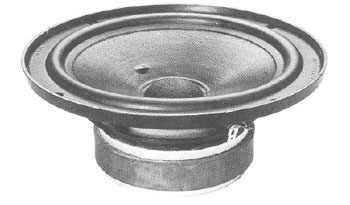
Vintage SEAS CA17RCY.
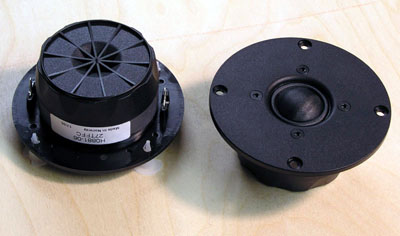
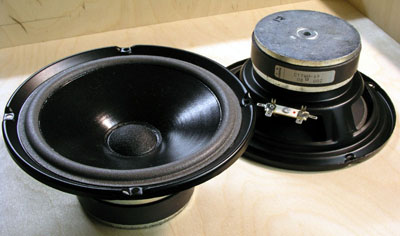
SEAS
27TFFC tweeter having just enough sensitivity to cope
with 2 x C17WH-69-08.
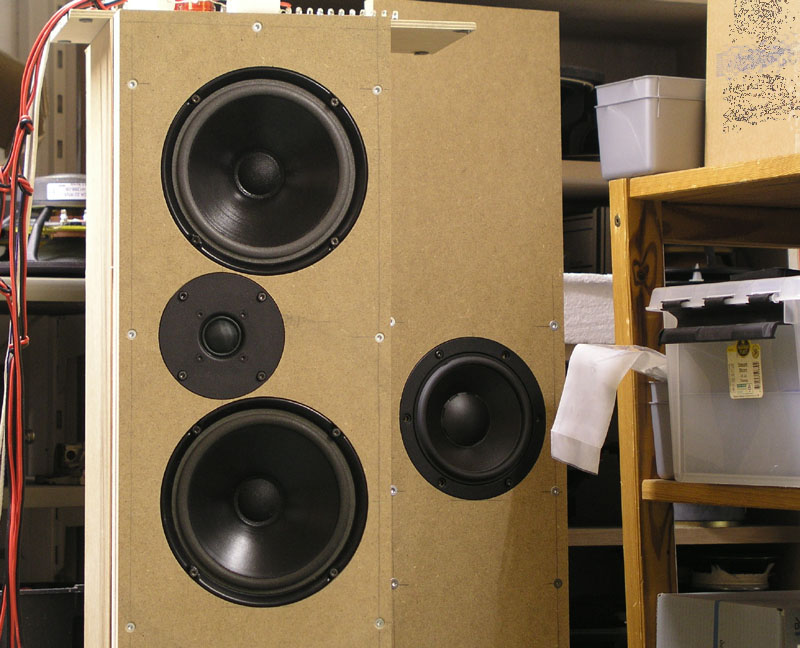
Workshop C17WH set-up with an AudioTechnology middriver
following the event.
Crossover:
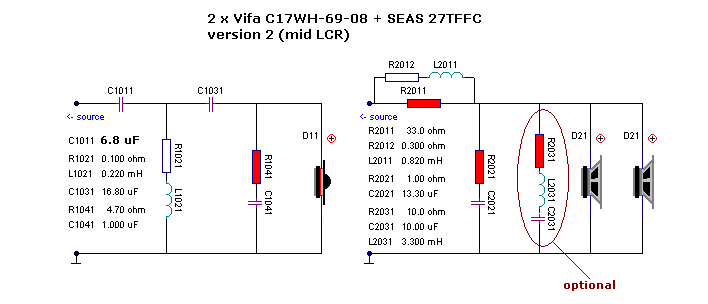
Crossover is quite
simple. Basically 3rd order topology, where 12 dB
electrically to the midbass does it. The notch
filter is optional, but I suggest you buy the few
components needed to try this. The 3.3 mH should
be cored and may have high resistance. 0.8 mm
wire is fine.
|
TS data
Measured
with the CLIO and added mass method used (10 grams).
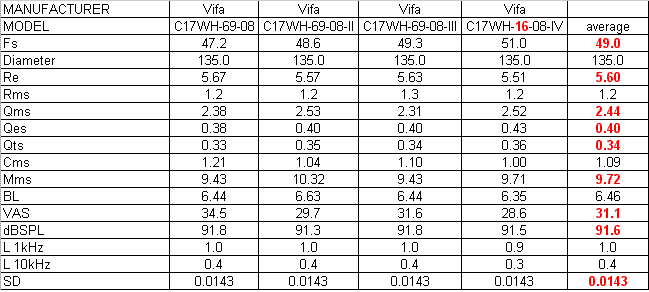
These drivers are
remarkably alike and no need to make pairs here.
The Qt = 0.34 is perfect for modelling. With an
18 litres cab (1 driver) the F3 is 62 Hz, which
may seem high, but the d'Appolito arrangement
delivers a very good bass performance. It may
have an early roll-off, but the slope is shallow.
|
Cabinet:
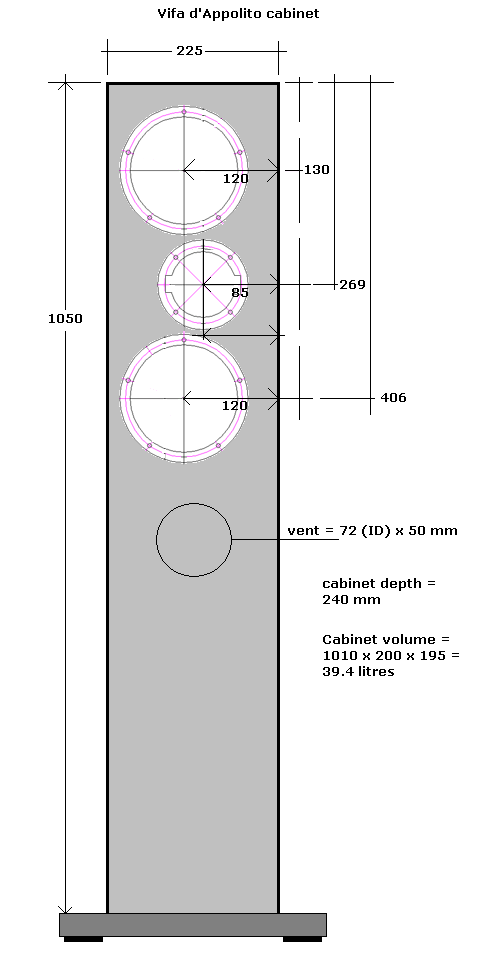
Not much to be said about
the cabinet. 19 mm MDF. I strongly suggest some
bracing at tweeter height, below lower midbass
and below vent. I have used an extended (depth)
2.5 clone test cabinet, thus the 225 mm width.
Place the vent to the rear to eliminate any
midrange emission. Make sure the front panel and
driver position is as on the drawing to make the
crossover work properly.
|
Measurements:
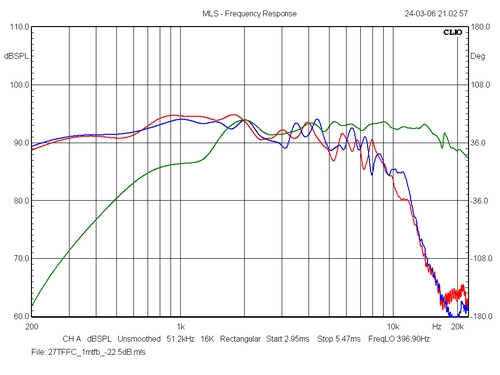
Individual response of
drivers. The response from the C17 drivers is not
the same due to different placement on the front
panel. For the LspCAD simulation both drivers in
parallel were measured at 1 metre distance.
Red = upper C17, blue = lower C17. Green = SEAS
27TFFC tweeter.
|
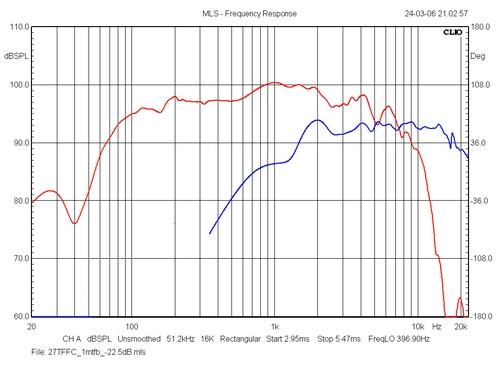
Connecting the C17 in
parallel reveals this picture. Note the 96-97 dB
sensitivity in the midrange. No serious break-ups
from the paper cones and a smooth roll-off above
7 kHz. The C17 response is merged with nearfield
measurement at 350 Hz.
|
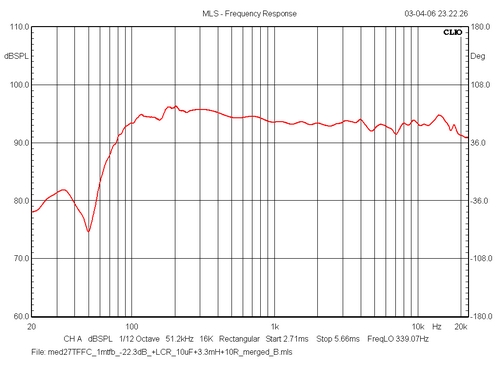
Here's the response of
the finished speaker including the midrange notch
filter.
|
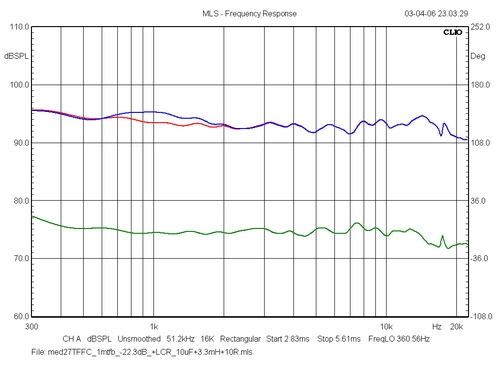
The impact of the
midrange notch filter is seen here. This may seem
a small difference, but try it and tell me what
you think. It makes quite a difference in terms
of midrange projection and adding the LCR circuit
may leave you listening to a wider range of your
recordings. 1-1½ dB in the 1 kHz area is clearly
noticeable. I'm still in doubt which I like the
most.
|
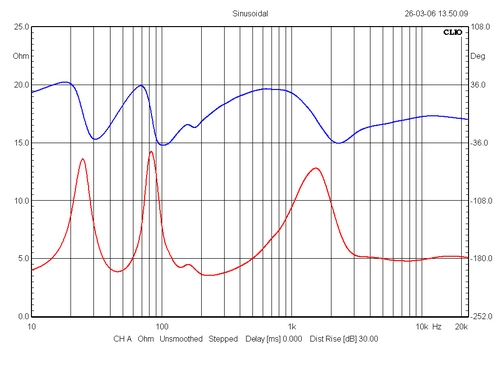
Impedance of final
construction. The notch at 170 Hz tells that some
work needs to be done on placement of the damping
material. Cabinet height is around 1 metre, which
equals half the wavelength of 344 Hz = 172 Hz.
If you want a flat impedance profile in the upper
midrange, ad an LCR circuit from 22 uF + 0.56 mH
+ 6R8 at crossover input.
|
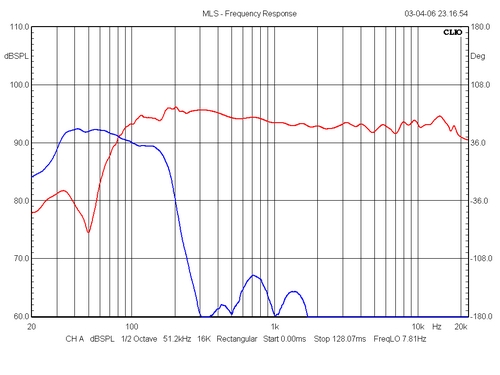
Port response. Quite
broad, actually. I still have to experiment with
other types of vents. I have some 80 mm vents I
have to try. Don't expect a lot of things going
on at 30 Hz.
|
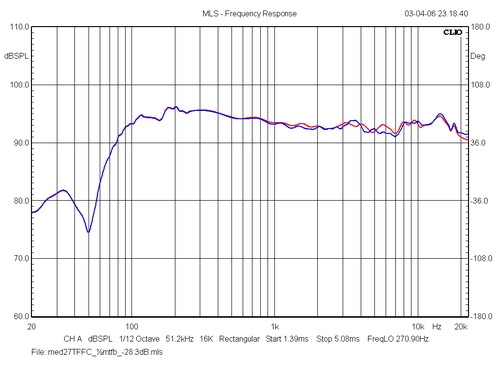
Left and right speaker.
Quite similar where it counts. The response here
is normalised for 2.8 volts signal at 1 metre
distance and reveals a sensitivity of around
94-95 dB in the midrange. This should equal an
efficiency of approx. 92 dB for 1 watt.
|
PS: While writing the draft of this
article I had the offer of an original pair of
C17WH-09-08 drivers. These are from 1982 and are still
going strong. I'll add the measurements asap and we'll
see how these drivers did some 25 years ago.
Here's the Vifa codes on drivers.
C17WH-69-08
C = steel basket
17 = diameter
W = woofer
H = 90 mm magnet
69 = custom, coated
08 = impedance.

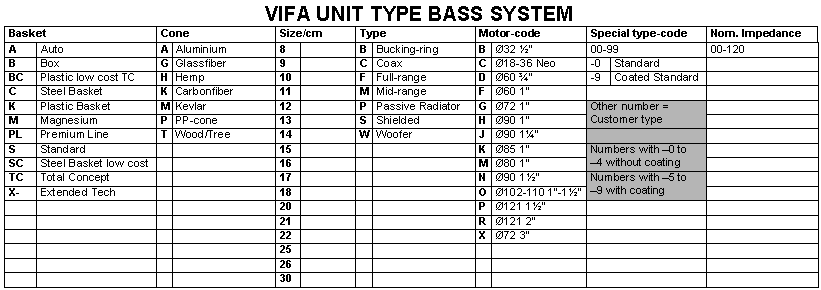
The really old
drivers:
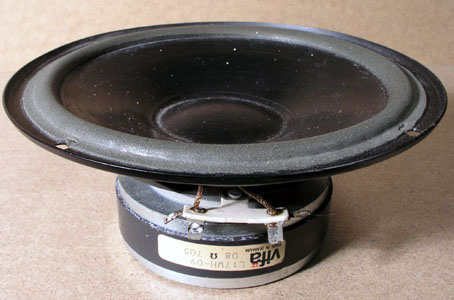 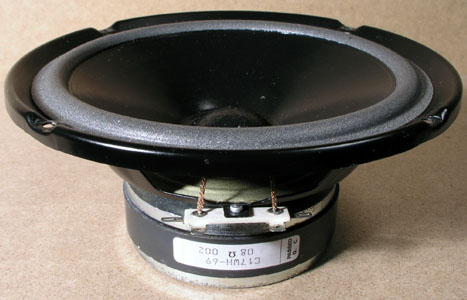
Left: 30 years old C17WH-09-08. The foam surround has never been
changed,
but my guess is that these surrounds
will not last
another 10 years unless the drivers are kept away from
any UV light.
Right: Current C17WH-69-08.
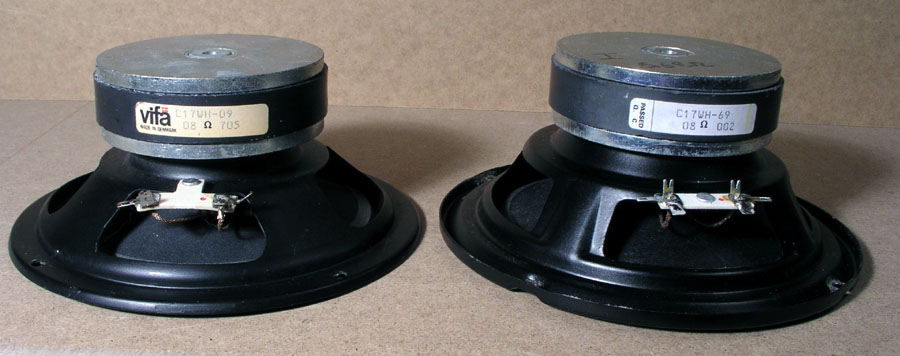
A few changes had taken
place since the early Eighties. The driver has
gotten a new chassis allowing a wider spider with
a possibly enhanced bass performance. And the
dust cap has been changed from a wide and shallow
paper dome to a small fabric dome. The paper dome
makes an overall flat cone geometry and this may
possibly have an impact on dispersion. Whether
there are any sonic differencess between the old
and the new drivers is difficult to tell. Setting
up the two 8 ohms drivers in the test cab with
the current crossover produced the below seen
frequency response and it sounded good.
|
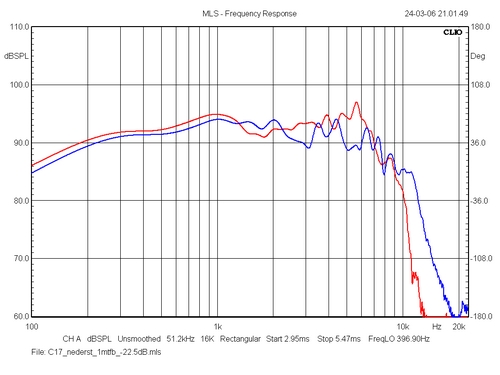
Lower speaker in both
cases: Red = old driver. Blue = new driver.
|
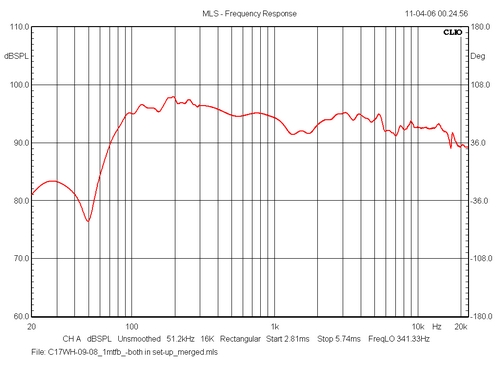
Frequency response from
the old drivers and current crossover.
The C17WH-09-08 paper dust cap is
used by Living Voice in their more expensive
variants of the speaker and having some spare
paper dust caps I might try replacing the current
fabric types. At the same time I might dampen the
pole piece as I'm sure this has not been done.
Despite the centre polepiece being ventilated (by
a very small hole), I'm sure there are resonances
between the dust cap and pole piece.
|
|




















